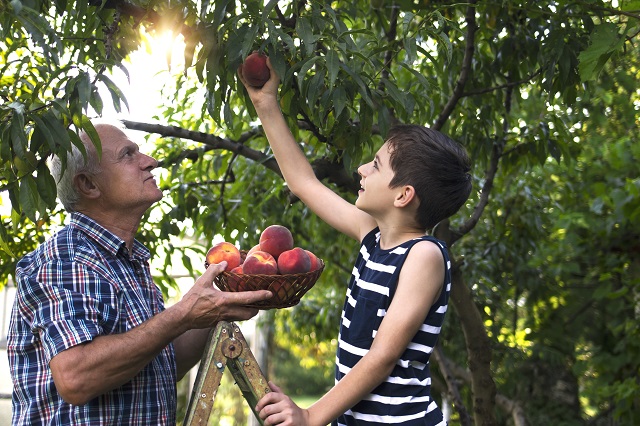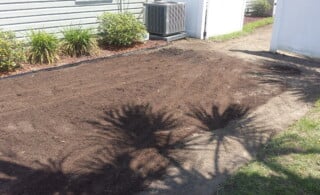Nothing compares to eating fruit picked right from your own tree. Whether you live in warm or cold climate and have a large back yard or no outdoor space at all, this guide is your key to maintain the best fruit trees.
On This Page:
Best Fruit Trees for Warm Climates
While growing fruit trees in warm climates may be a challenge, there are many low-maintenance trees that yield deliciously sweet fruit for you and your family to enjoy. These are some of the easiest fruit to grow in warm, sunny weather conditions:
- Plum
- Peach
- Pear
Plums
Compact and adaptable, plum trees are among the easiest fruit trees to grow in warm climates. They require little maintenance to grow delicious and beautiful fruit that is sure to enhance the look of your outdoor space.
Tips for growing plum trees:
- Plant at least two since these are not self-pollinating
- Make sure your soil is well-drained
- Provide full sun exposure and shield from the wind
- Water weekly through October to preserve your plum tree during winter months
Peaches
Nothing says summer like a juicy, sun-ripened peach. They come in many varieties for you to choose from fuzzy to fleshy skin. The delicious fruit from these warm-weather trees is also perfect for preserves that you will enjoy during colder seasons.
Tips for growing peach trees:
- Ideal for climates where the temperature doesn’t drop below – 20°F
- Avoid southern exposure when planting in colder zones to prevent an early bloom
- Plant in soil that is well-drained
- Most are self-fertile, so you can buy just one
Pears
Versatile and juicy, pears are among the easiest fruit to grow in warm weather. They have little issues with disease or insects and offer some of the greatest durability among fruit trees.
Tips for growing pear trees:
- Be patient, as pear trees take at least 3 years to produce fruit
- Grow your pear tree in well-drained soil and full sun
- Prune annually to produce the most fruit
- Plant at least two, since pears are not self-pollinating
The cost of pruning trees ranges between $200 and $800. Factors that affect this price include the size of the tree, its location, type, and overall health.
Best Fruit Trees for Cool Climates
Certain trees require a winter season to prepare for fruit production. These are the best fruit trees to grow in cool climates, as they love a chilling period:
- Mandarin orange
- Cherry
- Honeycrisp apple
Mandarin Oranges
With their fragrant blooms and bright colors, mandarin orange trees have become acclimated to the cold. This makes them ideal for gardeners in cool climates. They are among the easiest fruit trees to grow and an excellent choice for beginners.
Tips for growing mandarin trees:
- Choose dwarf mandarin trees for container culture
- These small varieties can grow inside all year long
- Satsumi is the coldest hardy variety
- Protect your mandarin tree from sudden drops below freezing
Cherries
Cherry trees are among the most beloved by gardeners because of their beautiful flowers, delicious fruit, and minimal maintenance. Dwarf varieties are self-fertile and produce sour cherries used for cooking, while sweet cherry trees require a pollinating partner to bear fruit that you will enjoy raw.
Tips for growing cherry trees:
- Use netting or scare tape to protect your crop from birds
- It can take up to 4 years for a cherry tree to produce fruit
- Provide moist soil and apply mulch around the base of your tree
- Fertilize your trees in the spring and prune them in late winter
Honeycrisp Apples
Honeycrisp apple trees are a favorite of gardeners in cool temperatures and a classic of fall recipes. They are among the best backyard fruit trees, though dwarf varieties can also grow in a pot.
Tips for growing honeycrisp apple trees:
- Apple blossoms require cross-pollination, so you need more than one tree to bear fruit
- Full sunlight is best for apple trees to produce more
- Grow your apple tree in well-drained loamy soil
- Spray your trees with store-bought or natural insecticides as needed to avoid pests and diseases
Find tree services to plant, grow, and maintain beautiful fruit trees that are healthy and productive.
Best Indoor Fruit Trees
While you may think that trees only produce fruit in large outdoor areas, there are many indoor fruit trees that are easy to grow and lovely to look at. If you can provide full sun for 6 to 8 hours, there are the best indoor fruit trees to grow delicious fruit that you will enjoy:
- Fig
- Olive
- Lemon
Figs
While fiddleleaf fig trees are known for their decorative qualities, there are other varieties of fig trees that produce fruit and thrive indoors. These self-pollinating fig trees sprout oblong leaves that also look great in your home.
Tips for growing indoor fig trees:
- For a 5-gallon size nursery tree, you need a pot with a diameter of 18 inches
- The size of your pot will determine how much fruit it produces
- Grow your tree in a loamy soil mix of clay and sand
- Water once a week
- Depending on the humidity of the room, mist regularly to create a moist environment
- Position in bright light
- Keep away from windy drafts to prevent drying of the leaves
- The leaves and sap of fig trees can be toxic or irritating to cats
Olives
If you like olives, you will love the indoor varieties of olive trees. They require less care than other fruit trees, are self-pollinating and produce large amounts of fruit throughout the year.
Tips for growing indoor olive trees:
- Only water your indoor olive tree when the top inch of soil has dried out
- Remember that your tree will take a natural rest in the fall and winter
- Supply at least 6 hours of direct sunlight each day
- Keep your tree away from wind draft to prevent frizzling of the leaves
- Safe for pets
Lemons
Dwarf lemon trees can bloom beautifully indoors without much care. They provide beautiful decoration and a delicious scent, while delivering a versatile fruit.
Tips for growing indoor lemon trees:
- Grow in a slightly acidic, loam-based soil
- Mist your tree regularly and keep the soil slightly moist, as indoor varieties love moisture
- 8-12 hours of direct sunlight per day are necessary for your indoor lemon tree to grow
- Meyer lemons are self-pollinating and can ripen in temperatures as low as 55 degrees
- Toxic to dogs and cats
The best arborists near you can help you grow indoor or outdoor fruit trees that decorate your home and produce nourishing crops for you and your family to enjoy.
FAQs
When should I buy fruit trees?
Replant pot-grown fruit trees between September and early May. Doing so when fruit trees are dormant ensures that your tree will survive the change.
Is it easy to grow fruit trees?
If you want your trees to grow and produce delicious fruit, you’ll need to prune and monitor them for pests. Start with varieties that grow well in your area for greatest ease and highest chances of success.
What are the fastest-growing fruit trees?
Peach, apple, coconut, and pear trees are the fastest growing fruit trees.
Which fruit trees produce the most fruit?
Figs, peaches, nectarines, citrus, black cherries, and mulberries are among the most productive fruit trees.
Need help maintaining your trees?
 Spring Garden Flower Tips and Suggestions
Spring Garden Flower Tips and Suggestions  Plan Ahead for a Better Yard
Plan Ahead for a Better Yard  Dry Well Cleaning & Maintenance Tips
Dry Well Cleaning & Maintenance Tips  Soil Engineers & Testing
Soil Engineers & Testing  How To: Build A Gas Fire Pit in 10 Steps
How To: Build A Gas Fire Pit in 10 Steps 

Are You Familiar With This Topic? Share Your Experience.